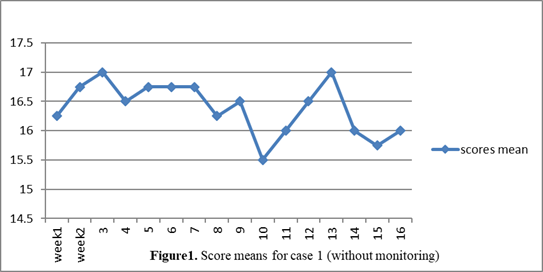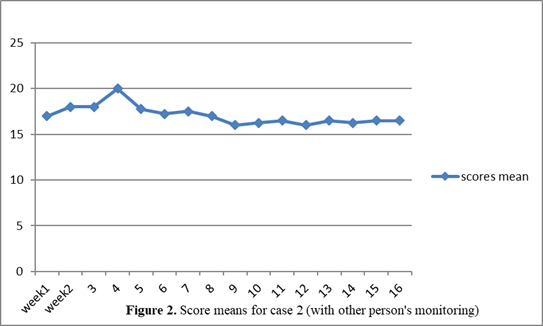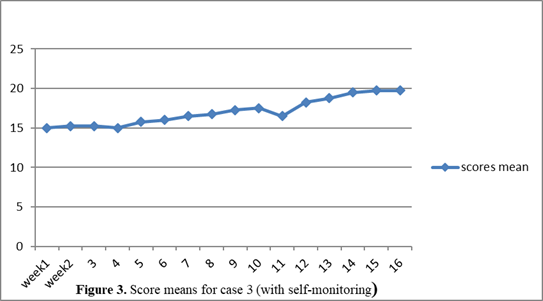Abstract
The aim of this study was to determine the effectiveness of a second person’s monitoring on learning compared with a self-monitoring approach to improve students’ academic achievement. To do so, the selected research method was a single case with multiple subjects included. The study subjects were three female students of Payame Noor University, Iran, 20 years old on their third study semester, enrolled in a management course in the same class, which had been selected in a purposeful way. The students’ mean first academic semester scores were recorded as a baseline for their academic achievement at the beginning of the study. The intervention commenced for subjects 2 and 3 at the same time; subject 1 had no intervention, the second subject had a second person monitoring and the third subject was self-monitored. At the end of each week, the subjects sat for an academic exam to record their pedagogic progress. Based on the research findings, the first subject had no obvious change in academic achievement (only a little improvement on the first sessions), the second showed a rapid improvement in academic scores, however, this was not a long-term improvement which became stable after four weeks. The third subject with the self-monitoring approach had a slow but long-term improvement during the study. Based on the study results however, the second person monitoring approach had a great effect on academic achievement; it had short-term effectiveness on the learner’s academic achievement compared with slow improvement in the same for learners with the self-monitored approach. It can be concluded, based on the present study, that the self-monitoring process had more sustained effects on academic achievement compared with second person monitoring.
Keywords: Second person monitoringself-monitoringacademic achievement
Introduction
1.1. What is Self-monitoring?
Self-monitoring is known as one of the metacognitive regulative strategies, with metacognition as cognition about cognition, knowing of knowing, and thinking on thinking. The prefix of “meta” means “beyond”, so then metacognition is something beyond cognition. Metacognition is a term introduced by John H. Flavell (1979), the American psychologist.
Metacognition is divided into Metacognitive Knowledge, Metacognitive Experience and Metacognitive Strategies. Metacognition also refers to personal thinking around one’s own thinking, learning, study, improvement and achievement.
Metacognitive regulative strategies contain three components of Planning, Monitoring and Evaluating.
In this context, monitoring means learner’s awareness, observing and monitoring of comprehension, learning and achievement. Peirce (2003), affirms that monitoring of learning makes learners aware of their learning problems, which Nickerson, Perkins, and Smith (1985) divided into problems of: 1) process of encoding, operation and goal setting, 2) cognitive load and 3) learner’s abilities. Hence, theoretically, recognizing these problems during learning attempts will be useful to improve learning and academic achievement. However, although many studies have affirmed this effectiveness (e.g. Harris, Friedlander, Saddler, Frizzelle, and Graham (2005), Harris et al., 2005; Rock, 2005; Shimabukuro et al., 1999), this author could not identify any research comparing self-monitoring and second person monitoring.
Studies have demonstrated that self-monitoring can be an effective intervention to increase academic engagement, enhance academic skills, productivity and accuracy, and, in this way, overall academic achievement (Carr & Punzo, 1993; DiGangi, Maag, & Rutherford, 1991; Rock, 2005; Shimabukuro, Prater, Jenkins, & EdelenSmith, 1999 cited by Manfore, 2012).
According to Reid (1996), self-monitoring of performance involves instructing students to self-assess some aspect of academic performance and to self-record the results. Research has affirmed that self-monitoring is effective even for learners with a variety of disabilities (Ganz, 2008; Lam, Cole, Shapiro, & Bambara, 1994; Mooney, Ryan, Uhing, Reid, & Epstein, 2005; Rafferty, 2010; Reid, 1996; Reid, Trout, & Schartz, 2005 cited by Manfore, 2012).
2. Problem Statement
Self–monitoring was shown to be an effective metacognitive strategy to improve academic achievement in some studies, but the effectiveness of a second person monitoring learning has not been considered.
3. Research Questions
1. Is the self-monitoring strategy effective in academic achievement for study cases?
2. Is another individual’s monitoring effective in academic achievement of cases?
3. Which approach is more effective to improve academic achievement of cases, self-monitoring or another’s monitoring?
4. Purpose of the Study
The aim of this study was determining the effectiveness of a second person’s monitoring on learning compared with a self-monitoring approach to improve Payame Noor students’ academic achievement.
5. Research Methods
Since the procedures of a detailed study, involving learning, achievement and considering monitoring was a long-term and time consuming, a single case study with multiple subjects was selected.
5.1. Subjects (cases)
The study subjects were three female students of Payame Noor University, 20 years old on their third study semester, studying in a management course in the same class, which had been selected in a purposeful way to reduce the issue of uncontrollable effects.
5.2. Procedure
First academic semester score means were recorded as the baseline for academic achievement at the beginning of study. The students’ means were approximately the same; 16.25, 16.5 and 16.25 (with a 20-point score scaling), respectively for cases, 1 to 3. The treatment (intervention) started for subjects 2 and 3 at the same time; subject one had no intervention, the second had a second person’s monitoring and the third was self-monitored. The subjects sat for an academic exam each week (over 16 weeks), so as to record their academic achievement progress.
6. Findings
As can be seen in table



According to the study findings presented in table
7. Conclusion
It can be concluded, based on the study findings, that, both monitoring approaches, self-monitoring and monitoring by another individual was effective in terms of academic achievement compared with no monitoring intervention. However the second person monitoring approach showed a great effect on academic achievement over the first weeks; this was a short term effectiveness, compared with slow improvement in achievement for case 3 with the self-monitored method. Regarding the present study results, It can be concluded that self-monitoring had a more long-lasting developing effect on academic achievement compared with the second person’s monitoring. Also, having a monitoring strategy was useful for both approaches. Hence, this could represent a new method, defining a mixed way of monitoring, too.
It can be recommended to conduct a comparative study regarding intrinsic and extrinsic motivational approaches for learners, since it is probable that, in our cases, be intrinsic and then the monitoring made by her selves be more effective according to. Regarding the study results in the case with self-monitoring intervention showing continuous improvement in academic scores, it is suggested to study the effects of self-monitoring on learning motivation as a critical variable in learning processes. Finally, as Papaleontiou-Louca (2008) declares, the usage of metacognitive strategies of self-awareness and self-monitoring results in more independence for student learners, since they will be able to manage their study and learning, and even their lives. For learning, metacognitive strategies such as self-monitoring may become a recognized research subject, which could improve quality of life too, since metacognition is knowledge of knowledge.
Acknowledgments
Heartfelt thanks to the valued study subjects, who participated in the long process of study, multiple exams and instructional sessions in this study.
References
- Flavell, J. H. (1979). Metacognition and cognitive monitoring: A new area of cognitive–developmental inquiry. American Psychologist, 34(10), 906.
- Harris, K. R., Friedlander, B. D., Saddler, B., Frizzelle, R., & Graham, S. (2005). Self-monitoring of attention versus self-monitoring of academic performance: Effects among students with ADHD in the general education classroom. Journal of Special Education, 39(2), 145-156.
- Menzies, H. M., Lane, K. L., & Lee, J. M. (2009). Self-monitoring strategies for use in the classroom: A promising practice to support productive behavior for students with emotional or behavioral disorders. Beyond Behavior, 18(2), 27-35. Retrieved from http://www.ccbd.net/publication/beyondbehavior
- Monfore, Mike. (2012). Self-Monitoring of Student Academic Performance, Virginia:Virginia Department of Education. http://ttac-esd.gmu.edu/my_files/Self-Monitoring_of_Academic_Sup_Doc.pdf
- Papaleontiou-Louca, Eleonora. (2008). Metacognition and Theory of Mind. Cambridge: Cambridge Scholars Publishing. http://www.cambridgescholars.com/download/sample/59586
- Pierce, W. (2003). Metacognition: study strategies, monitoring and motivation, www.academic.pg.cc.md.us.
- Reid, R. (1996). Research in self-monitoring with students with learning disabilities: the
- present, the prospects, the pitfalls. Journal of Learning Disabilities, 29(3), 317-331.
- Shimabukuro, S. M., Prater, M. A., Jenkins, A., & Edelen-Smith, P. (1999). The effects of self-monitoring of academic performance on students with learning disabilities and ADD/ADHD. Education and Treatment of Children, 22(4), 397-414.
Copyright information

This work is licensed under a Creative Commons Attribution-NonCommercial-NoDerivatives 4.0 International License.
About this article
Publication Date
16 October 2017
Article Doi
eBook ISBN
978-1-80296-030-3
Publisher
Future Academy
Volume
31
Print ISBN (optional)
-
Edition Number
1st Edition
Pages
1-1026
Subjects
Education, educational psychology, counselling psychology
Cite this article as:
Molaee, Z. (2017). Effectiveness Of Second Person And Self-Monitoring Approaches In Academic Achievement. In Z. Bekirogullari, M. Y. Minas, & R. X. Thambusamy (Eds.), ICEEPSY 2017: Education and Educational Psychology, vol 31. European Proceedings of Social and Behavioural Sciences (pp. 1-7). Future Academy. https://doi.org/10.15405/epsbs.2017.10.1

